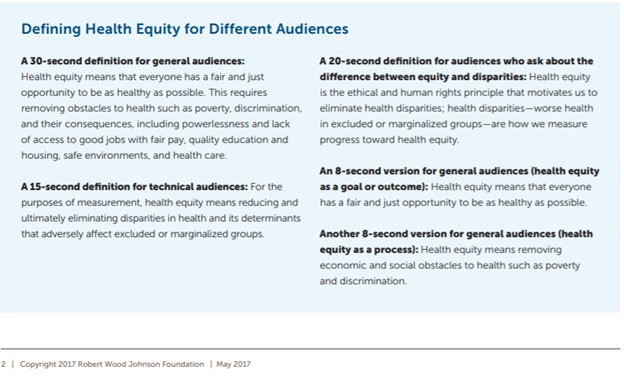
Resources are tools. Evidence is what we know. Gaps are what we don’t. These are essential components of engaging health equity. Blog posts #1 and #2 provided lots of resources to dip your toe into the waters. Now, let’s venture further.
Background: Know Your History and the Context
Health Equity: Syllabus from Project SHARE, University of Maryland-Health Sciences and Human Services Library
Racial Equity: Eddie Moore Jr’s 21-Day Racial Equity Challenge
Disability Equity: Brandeis-Heller’s 7-Day Neurodiversity Challenge
Health Equity Definitions
The Robert Wood Johnson Foundation recommends different health equity definitions for different audiences.

Book: Health Equity: A Solutions-Focused Approach (July 2020) has many useful chapters; the first two of which are freely available.
Journal Articles: Health Disparities and Health Equity: The Issue is Justice (2011); How Structural Racism Works (2021); Gender, Sexes, and Health: what are the connections – and why does it matter? (2003)
Film: Unnatural Causes – a 7-part series that highlights the social determinants of health, particularly the root causes of socio-economic and racial inequities in health.
Report: What Is Health Equity? – part of the Robert Wood Johnson Foundation’s Achieving Health Equity initiative. This item includes taking action for health equity with resources that focus on evidence and action steps for everyone – and by sector.
University Initiative: Resources for learning and measuring progress toward creating an equitable institution.
Data & Measurement: Examining change.
diversitydatakids.org
Racial Equity Data Roadmap (Massachusetts Department of Public Health)
Equitable Data Practice
Study Design & Data Collection:
Equity Checklist for Systematic Review
Urban Institute Guide for Racial Equity in the Research Process
Evidence and Equity: Challenges for Research Design
Racial Equity Tools: Data Collection Methods
Use these pieces to learn and question. Think about one thing you can do tomorrow, next week, next month, within 6 months, within a year. Think about the people and places that need to be part of these actions.
Don’t ask others to do this work for you. It is not anyone else’s job, especially those populations who are disproportionately affected by the systemic inequities discussed. Do know you will make mistakes. Do know other people will make mistakes. Organizations will continue too as well. Keep learning. Keep asking questions. Keep doing the work.
It’s all well and good to use “the words”, but when your actions don’t reflect the words – you’re not doing the work. Engaging Health Equity means that we’re mindful about words, but especially mindful about what we do.
Essential to this is operationalizing (moving from concept to action) definitions into frameworks and actions. Working toward health equity then becomes the litmus test for every hiring and promotion decision, family leave policy, and community program offering. Achieving health equity is an iterative process, not only a goal or outcome.
There is no way I – or anyone else – can exhaustively cover all that is health equity. My goal here is to demonstrate, if only partially, the breadth of its meaning. And particularly, to continue a conversation that requires that we all participate and plan for action. We must look to the evidence while simultaneously questioning it: what was measured, what was tested, and who was involved. Using evidence and questioning it are compatible – and central to pursuing health equity. This dance will move us forward.
The American Public Health Association’s Advancing Health Equity brief provides many definitions related to the social determinants of health and equity. It also describes relevant evidence, provides “how-to” resources, and names key principles for action, with next steps. The Advancing Health Equity Key Principles are:
Certainly, we’ve barely even scratched the surface. Share what you’ve been reading, watching, listening to, and most importantly doing. There is no one way to approach health equity.
More from Dr. Lindsay Rosenfeld here.
HPHR.org was designed by ComputerAlly.com.
Visit HPHR’s publisher, the Boston Congress of Public Health (BCPH).
Email communications@bcph.org for more information.

Click below to make a tax-deductible donation supporting the educational initiatives of the Boston Congress of Public Health, publisher of HPHR Journal.![]()